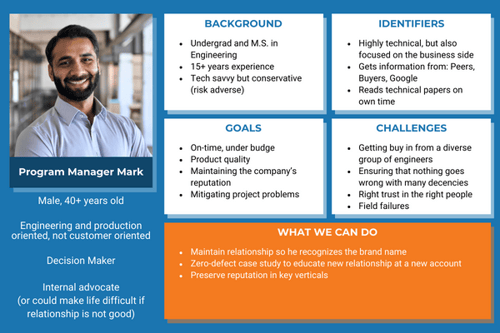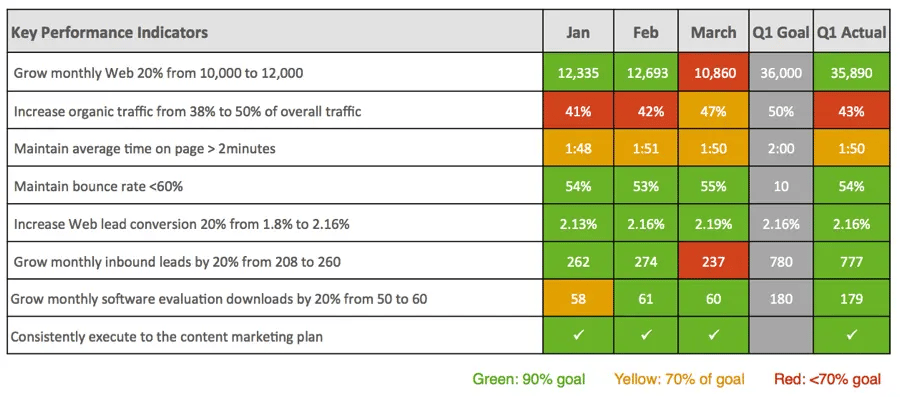An Engineer's Guide to B2B Marketing Planning
Preparing for Your 12-Month Marketing Plan

Introduction
A marketing plan is a roadmap that outlines all of your marketing goals, audiences, initiatives, tactics, budget, and expected results over a period of time -- typically produced annually.
A good marketing plan can help you reach your target audience, boost your customer base, and ultimately, increase your bottom line. Developing a plan requires research, time, and commitment, but is a very valuable process that can greatly contribute to your business success.
But is your organization ready for a marketing plan?
Before you get started, make sure you can answer "yes" to the following four questions.
Do you have a clearly defined business strategy with measurable goals and objectives?
Successful marketing plans start with defined business goals. Before jumping into marketing tactics and execution, you must define business goals for the next 1-3 years. This includes understanding your key products and services, the differentiators between you and your competitors, your target audience personas, and the competitive landscape you face. This closely informs how you set marketing goals and tactics and helps you define what success will look like.
Do you have budget defined for implementing annual marketing activities?
A guideline for this is 6-12% of gross revenue with higher spending in the early phases as you build your marketing foundation. You should stabilize at a lower rate of spending as you build momentum, but account for spikes in spending as you execute major initiatives such as product launches or a website redesign.
Do you have an organizational structure to support marketing?
With a budget in place, you need a team with clearly defined roles so you can be as efficient as possible in planning, executing, and measuring your marketing program. Though each company organizes its marketing team based on unique culture, budgeted and expected outcomes, you can choose from an in-house, agency, or hybrid model. Each one has pros, cons, and cost variations to consider and thoroughly evaluate before making the best choice for your company.
A bare minimum inbound marketing program requires 15-20 hours per week to create one content piece a month, blog once a week, manage leads, support sales needs, promote content, update the website, and assess results.
If you don't currently have a marketing team, finding an agency with proven expertise in your industry or niche is a good place to start. Once you have your marketing foundation in place, you can look to hire an in-house marketing coordinator that can work alongside your marketing agency to write/post blogs, promote content on social channels, and support your sales team. As you build up your marketing acumen and grow your business, you can build an in-house team when you're ready.
Do you have multiple products and or service offerings and annual revenue greater than $5M?
If you have one or two products or services and you’re just getting your business started, you might only need a product launch plan or to define your target personas and create your brand positioning and messaging.
If the answers to all of the above questions is "yes," then you are ready to move forward.
Document Your Business Goals
Frequently in marketing planning, companies consider their marketing plan finished when they list the disparate tactics needed to execute specific wants and needs, such as a website redesign or blog implementation. Then, they dive right into the execution without determining the purpose, setting expectations, or prioritizing resources.
Instead, they rush down any road that looks promising at the moment. Unfortunately, these unplanned roads lead to mediocre results and higher costs, in time, money, stress, and frustration. It is important to take the time to define your marketing plan and formulate an investment strategy to reach your business goals.
Before jumping into the tactics and execution, your marketing team should ask the leadership team to define their business goals for the next 1-3 years. Your goals can be externally focused, internally focused, or perhaps a mix of both.
Here is a list of areas you may build your business goals around:
- Improve customer satisfaction
- Establish or increase brand awareness
- Find new markets for products or services
- Expand product or service lines
- Decrease time to market
- Improve employee satisfaction
- Increase management communication
- Reduce operational costs
- Generate new sources of revenue
Review Your Business Strategy
In order for marketing to help drive your business and meet your top-level goals, your plan must be aligned to business priorities. Start by looking at your company’s business goals and identifying where marketing can help.
Next, dive into key markets and focus areas, look at the current break out of your revenue by industry or application area and document projected growth areas. Identify industries that need additional marketing focus next year and new markets you plan to target. Just as important as deciding where to invest is identifying any areas of divestment, which will help you divert resources to the biggest areas of opportunity.
Audit Your Current Marketing Activities
A successful marketing plan ensures you have the right mix of activities that increases brand awareness and preference and that generates a consistent flow of high-quality leads to help fuel new sales opportunities and grow revenue. Use a smart marketing approach that builds a marketing strategy and execution plan to set your business up for success. Once your leadership team has created or updated and documented business goals and strategy, engage them along with a few other key stakeholders across the organization to create your marketing advisory team. This is typically up to five stakeholders including the head of marketing, head of sales, senior sales manager, senior engineer, and the president or CEO.
Once your marketing advisory team is in place, conduct a marketing audit to gauge current state of your marketing efforts.
Consider the following as you audit the current state of your marketing program:
Brand Positioning and Messaging
-
You have a defined, documented and well understood brand position and message
-
The last time you updated your 30- word corporate pitch, mission, vision, value proposition, and corporate slide presentation
-
Note your top four differentiation pillars compared to your competitors
Brand Identity
-
The color palette, logo, and imagery style you are using across tactics and if they are used consistently. Is it time for a refresh?
-
Do you have a documented brand identity style guide?
Content
-
What types of content are you creating (blogs, white papers, case studies, videos, etc)?
-
Is content optimized for SEO best practices?
-
Who manages, writes and promotes content, and how much time does it take?
-
How frequently is content promoted?
Website
-
The design and when it was last updated
-
The number of web sessions generated each month
-
Activities/content that drive traffic
-
Engagement metrics, such as time on site and bounce rate
-
Domain authority
-
Traffic percentage by source, specifically organic search, direct traffic, social media and paid channels
-
Partners/distributors that are generating referral traffic to the site
Sales & Marketing Alignment
-
Note your monthly volume of form submissions, leads, marketing qualified leads, sales qualified leads, opportunities, and new projects.
-
Include how frequently the sales and marketing teams meet to discuss key projects, share successes and challenges, revise goals/quotas, etc.
Marketing Tools and Systems
-
List out current tools and systems used (customer relationship management, content management, marketing automation, email marketing, project/ process management, quoting, etc.).
Channel Partners
-
What partners do you work with and how do they help generate/close new business?
-
Are there areas of opportunity for co-marketing activities like jointly hosted webinars, case studies, enewsletter promotion or contributed blog posts?
Events
-
Note events you attended and plan to attend again. Include total spend compared to success measures including: leads generated, new business attained, speaking opportunities, sponsorship opportunities, booth presence, demos, number of technical sessions given.
Develop Your SWOT Analysis
A SWOT analysis is a framework for identifying and analyzing the internal and external factors that can have an impact on the viability of a project, product, or service.
Elements of a SWOT Analysis
- Strengths: Internal attributes and resources that support a successful outcome
- Weaknesses: Internal attributes and resources that work against a successful outcome
- Opportunities: External factors that the organization can use to its advantage
- Threats: External factors that could negatively impact the organization’s success
Define Your Buyer Personas
During the marketing planning process, it’s important to consider the different personalities that make up your target audience, what they care about, and what they need so you can ensure you have the right mix of marketing activities to engage them.
Buyer personas are fictional representations of your ideal customers based on real data pertaining to customer demographics and online behavior as well as your educated speculation about their personal histories, motivations, and concerns.
With personas, you can put faces to your customer segments and have the ability to better customize your marketing efforts – from messaging to activity selection – and make a greater impact with your prospects.
For example, you may define one of your buyer personas, Corporate Engineer Charlie, who is a business executive and cares most about cost and long-term support. Another persona may be Engineer Elliot, an engineering manager or staff member who wants to know very specifically about the technical capabilities of your product or how you deliver a service. With your personas defined, you can more easily visualize your target audience and plan your segmented communication with them.

Categorize your primary customer types to best describe their goals, pain points, and purchasing process.
To create a buyer persona, identify the following type of information:
- Who are they? Demographics such as gender, age, and education
- What is their job? Data such as title, company size, industry, and general job responsibilities
- What is a day in their life like? Describe what an average day is like for them, who they are dealing with, and what decisions they are making
- What are their primary pain points? Describe the primary challenges they are trying to overcome that relate to your products and services
- What do they value most and what are their goals? Explain what they value most in making a purchase decision (price, support, etc.), what they are trying to accomplish in each application
- Where do they go for information? Identify the primary sources they use to gather information in their research and purchase decision process
- What’s important to them in selecting a vendor? List what is most important, such as being a technology leader, having proven experience, being a domain expert, etc.
- What are their most common objections? List the reasons you hear most often for why your solutions won’t meet their needs
It’s best to limit the number of personas to three when you first start and then build from this level to further refine your personas and generate new ones as needed.
Once you have your buyer personas defined, you can be much smarter about your monthly content calendar planning and lead nurturing efforts. A new lead generated from a white paper or other premium content isn’t necessarily ready to speak with sales or make a purchase from you. You need to nurture that person over time, building trust and credibility between your company and the lead as he or she gains knowledge of your products and services.
Develop Your Marketing Goals
Armed with your business strategy, areas of greatest opportunity, and defined persons, you are now ready to create your marketing goals.
Goal setting is critical to aligning your marketing organization, narrowing your focus, and setting your overall marketing strategy.
Documenting your marketing goals is critical to ensuring your team is aligned around your top marketing priorities and what you expect to achieve through your marketing efforts. Your goals can be externally focused, internally focused, or perhaps a mix of both.
Here is a list of example areas you may build your marketing goals around:
- Increase brand awareness
- Demonstrate thought leadership
- Develop an online rapport with your customers
- Penetrate a market or application space
- Launch a new product or service
- Increase web visits from organic search traffic
- Increase web leads from online content
- Implement a new website content management system
- Communicate more frequently with stakeholders including employees, channel partners, distributors, etc.
Write your goals in the SMART format to ensure accountability. SMART stands for:
- Specific
- Measurable
- Attainable
- Realistic
- Time-Bound
For example, a SMART marketing goal could be: “Increase by 15% the number of qualified leads passed to sales in the military market by Q4 2020”. Develop at least three, and no more than five, SMART marketing goals.
Finally, define accountability and dependencies including:
- Who is responsible for ensuring progress on the goal?
- Is there an executive sponsor?
- Does success depend on action from other teams, a product release, or implementation of new technology?
Considering these things up front and gaining cross-organizational alignment will go a long way in helping you achieve your goals and drive success.
Build Your Activity Plan
Now that you’ve created your marketing goals and have a budget, you are ready to develop your activity plan..
The most effective way to approach turning your marketing strategy into an execution plan is by using a campaign structure. You can think of campaigns as buckets of activities focused on a common theme or goal.
With limited time and budget, a campaign approach gives you the big picture before you get into the weeds of which new video you will produce, which white paper you will write and promote, etc.
A marketing campaign is an integrated set of activities coordinated closely to achieve a common goal. Campaigns are often centered on an industry, audience type, partnership or major product/service initiative. Campaigns also include differentiators and core messages targeted to your personas to communicate your brand position consistently across content channels.
Here are two examples of marketing campaigns and their stated goals and KPIs:
Campaign 1: Lead Generation and Conversion
- Description — Through content and partner co-marketing, attract quality leads that convert to opportunities
- KPI — Increase leads by 35 percent to 210 per month
- KPI — Increase lead opportunity conversion from 6 to 8 percent
Campaign 2: Partner Marketing
- Description — Develop and implement a channel co-marketing program
- KPI — Publish at least one lead-generating piece of co-branded content per quarter
- KPI — Generate 100 net new leads through co-marketing activities
At this stage, you’ll map out campaign plans in a budget- based, 12-month activity plan. This plan outlines specific activities by quarter and is intended to be a living document.
Call your marketing advisory team together quarterly, to review the activity plan and make modifications or updates based on new opportunities, changing business needs, and/or the outcome of activities. This is also the time to identify internal staff and external resources needed to carry out the activity plan, measure results, and define the responsibilities of each person.
Set Your Success Measures
When developing a marketing plan, determining how you’ll measure the success of your activities is as important as identifying the activities themselves. Are you making progress toward your marketing goals? Which activities are bringing in the most leads? Are you attracting new contacts and if so, from what content and promotional channels?
Here are the key metrics to include on your marketing scorecard to help determine if you are focusing on the right activities and to ensure you are getting return on your marketing investment.
Web Performance Metrics
- Web sessions: 10-20% growth year over year
- Bounce rate: <60%
- Time on site: >2 minutes
Since your website is the hub of all inbound marketing efforts, web traffic is a staple on any marketing scorecard and a good measure of the overall health of your marketing program.
Going one step further, measuring bounce rate and session duration gives you insight into how well you’re engaging your audience. Maintaining a bounce rate at or below 60% indicates visitors coming to your site are finding what they are looking for. Session duration, or time on site, tells you how well your content is doing to keep them there. Aim to maintain average session duration of at least 2 minutes.
SEO Performance
- Organic traffic as a percentage of overall: >50%
- Domain authority: incremental growth from where you are
- # of keywords you're ranking for: at least your top 5
Visitors who come to your site from organic search typically stay longer, engage more, and are more likely to become new contacts. Start from where you are but aim to get to at least 50% and ideally 65% of your overall coming from organic search over time.
Other ways to measure your SEO efforts include monitoring how you are ranking for your top keywords and keeping an eye on your site’s domain authority. Domain authority is a score – on a scale of 1 to 100 – that Moz developed to predict how well your website will rank on search engine result pages. It takes a while to improve your domain authority score, so aim for an increase of 2-3 points per year.
Conversion Through the Funnel
- Web visits to leads
- Leads to MQLs (marketing qualified leads)
- MQLs to SQLs (sales qualified leads)
- SQLs to opportunities
- Opportunities to customers
Are you moving the visitors who come to your site down the funnel? Full funnel reporting is the best way to tie revenue to marketing activity and to identify any trouble areas along the way.
First, start tracking this to establish benchmarks and create a predictable model. Once you have that model, you can see the impact at each stage when you implement new activity to evaluate effectiveness.
This report is also a great tool to use to align marketing and sales goals, expectations, and handshakes and will help you determine when you may need to add additional activity to meet your goals.
Executing to the Plan
- Content publishing frequency
- Email and eNewsletter execution
- Monthly data-driven Web design updates
Not all your metrics have to be numeric. If consistently creating content is an important goal for you, for example, it may be worth putting on the scorecard even if the success measure is just yes or no. This helps maintain accountability and highlights the connection between consistent execution to the plan and achieving each of your other marketing metrics.

Example Marketing Scorecard
Once you’ve established your marketing scorecard, report on the metrics monthly. Perform deeper analysis on a quarterly basis and make changes to your plan based on what’s working and what’s not to ensure you reach desired results.
Conclusion
Strategy is an evolution, and something that takes a great deal of time to develop. However, mapping out a clear, strategic direction will ensure a cohesive marketing plan that maps to your personas through campaigns and is time bound and budget driven.
For a checklist to help you navigate each step in the marketing planning process, download the complete guide.
To learn more about the marketing planning services we offer, click here.
Watch the Webinar
Marketing Planning 101
A strategic B2B marketing plan is a necessary part of your marketing process, but it can also be a daunting task if you’ve never done one before or don’t have much experience.
In this on-demand webinar, Jennifer Dawkins, Vice President of Account Services, and Lee Chapman, President, walk through key marketing plan steps, including:
- Identifying your key markets and target audiences
- Evaluating your current marketing strengths, weaknesses, opportunities and threats
- Developing marketing goals that tie to your business goals
- Defining your current and desired future state
- Selecting key initiatives
- Setting success measures
- Building an action plan
Speakers

Jennifer Dawkins
Vice President of Account Services
TREW Marketing
Jennifer has been successfully marketing to engineers and scientists for nearly 20 years. Her marketing experience spans from defining company narratives and developing integrated marketing campaigns to building mutually beneficial partner relationships and maximizing performance in cross-functional teams. At TREW Marketing, Jennifer’s focus is collaborating with clients to develop marketing strategy and customized plans that map to corporate goals, drive results, and serve the business.

Lee Chapman
President
TREW Marketing
Prior to joining TREW, Lee was part of the corporate marketing leadership team at National Instruments (NI), where over the course of her 11-year career she served in various roles including Corporate Content and Community Relations Manager, Creative Strategy and Design Group Manager, and Brand Policy Manager. She now guides TREW's agency strategy and brings extensive B2B technical marketing experience across a spectrum of industries and application areas including test and measurement, control and automation, and industrial manufacturing.







